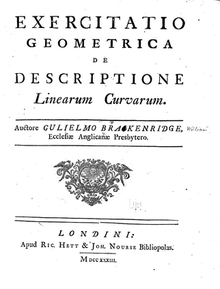William Braikenridge
William Braikenridge (also Brakenridge) (c.1700–1762) was a Scottish mathematician and cleric, a Fellow of the Royal Society from 1752.[1]
Life
He was son of John Braikenridge of Glasgow.[2] In the 1720s he taught mathematics in Edinburgh.[3]
Braikenridge was Honorary A.M. in 1735,[4] and D.D. in 1739, of Marischal College, when he was vicar of New Church, Isle of Wight.[5] He was incorporated at The Queen's College, Oxford, in 1741.[2] He became rector of St Michael Bassishaw, and from 1745 librarian of Sion College, in London.[6][7]
Works
In geometry the Braikenridge–Maclaurin theorem was independently discovered by Colin Maclaurin.[8] It occasioned a priority dispute after Braikenridge published it in 1733;[9] Stella Mills writes that, while Braikenridge may have wished to establish priority, Maclaurin rather felt slighted by the implication that he did not know theorems in the Exercitatio that he had taught for a number of years.[10]

- Exercitatio Geometrica de Descriptione Linearum Curvarum (1733)
- Proposals for lectures on the principles of mechanicks and natural philosophy, by Mr. Braikenridge: Formerly teacher of the mathematicks at Edinburgh (1750?)[11]
- A Letter from the Reverend William Brakenridge, D.D. and F.R.S. to George Lewis Scot, Esq; F. R. S. concerning the Number of Inhabitants within the London Bills of Mortality (1 January 1753), in Philosophical Transactions. This paper was topical, because parliament was considering legislation on a census and registration of vital information. Braikenridge argued, from bills of mortality, that London's population had peaked a decade earlier; a controversy arose with Richard Forster of Great Shefford[12] George Burrington also answered, in 1757.[13] It was argued against Braikenridge that population was increasing, near the area he considered.[14]
- A letter to the right honourable the earl of Macclesfield, president of the Royal society, concerning the method of constructing a table for the probabilities of life at London (1755)
- A Letter to the Right Honourable Hugh Earl of Marchmont. F. R. S. concerning the Sections of a Solid, Hitherto Not Considered by Geometers; From William Brakenridge, D. D. Rector of St. Michael Bassishaw London, and F. R. S. (1759)
- Sermons on Several Subjects by the Late William Brakenridge[15] To which Jane Austen's father, the Rev. George Austen subscribed whilst a fellow of St. John's College.[16]
Notes
- The Royal Society, Brakenridge; William (c 1700 – 1762).
- s:Page:Alumni Oxoniensis (1715–1886) volume 1.djvu/169
- O'Connor, John J.; Robertson, Edmund F., "William Braikenridge", MacTutor History of Mathematics archive, University of St Andrews.
- Peter John Anderson (editor), Fasti Academiae Mariscallanae Aberdonensis: selections from the records of the Marischal College and University, MDXClll–MDCCCLX vol. 2 (1889) p. 308; archive.org.
- Peter John Anderson (editor), Fasti Academiae Mariscallanae Aberdonensis: selections from the records of the Marischal College and University, MDXClll–MDCCCLX vol. 2 (1889) p. 82; archive.org.
- James Darling (1854). Cyclopaedia Bibliographica: A Library Manual of Theological and General Literature, and Guide to Books for Authors, Preachers, Students, and Literary Men. Analytical, Bibliographical, and Biographical. s.n. p. 422. Retrieved 18 June 2013.
- Sion College and Library. CUP Archive. 1913. p. 357. GGKEY:ZARA8NG8R2Z. Retrieved 18 June 2013.
- Florian Cajori (1991). A History of Mathematics. American Mathematical Soc. p. 228. ISBN 978-0-8218-2102-2. Retrieved 18 June 2013.
- Colin MacLaurin; Ian Tweddle (1 January 2007). MacLaurin's Physical Dissertations. Springer. p. 3. ISBN 978-1-84628-776-3. Retrieved 18 June 2013.
- Stella Mills, Note on the Braikenridge–Maclaurin Theorem, Notes and Records of the Royal Society of London Vol. 38, No. 2 (Mar. 1984), pp. 235–240, at p. 239. Published by: The Royal Society. Stable URL: https://www.jstor.org/stable/531819
- Catalogue page
- Andrea A. Rusnock (12 February 2009). Vital Accounts: Quantifying Health and Population in Eighteenth-Century England and France. Cambridge University Press. pp. 195–7. ISBN 978-0-521-10123-3. Retrieved 18 June 2013.
- George Burrington (1757). An answer to Dr. William Brakenridge's letter concerning the number of inhabitants, within the London Bills of Mortality: wherein the Doctor's letter is inserted at large, his arguments proved inconclusive, and the number of inhabitants increasing. J. Scott. Retrieved 18 June 2013.
- Paul Langford (1992). A Polite and Commercial People: England, 1727–1783. Oxford University Press. p. 636. ISBN 978-0-19-285253-3. Retrieved 18 June 2013.
- William Brakenridge (May 2010). Sermons on Several Subjects by the Late William Brakenridge. BiblioBazaar. ISBN 978-1-140-94108-8. Retrieved 18 June 2013.
- Braikenridge, William (1764). "Sermons on several subjects".